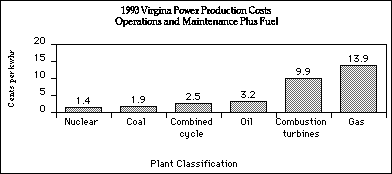How Expensive Is Nuclear Power?: Nuclear Cost Data In The United States
It is difficult to convince people to stop believing an assertion they have heard over and over again, no matter how false the statement is. One of these false statements is that nuclear electricity is more costly than fossil generated electricity.
One must understand that there are 109 different nuclear power plants operating in the U.S. Each of them is unique.
- They were designed by one of four different companies.
- They were built over a 30 year period.
- They were built in various locations under the supervision of different architect /engineers.
- They are being operated by a over a dozen companies with variations in management skills, operator training programs and contractor support.
The best nuclear plants in the country are quite competitive with the best fossil plants in the country. In a recent five year survey by the Utility Data Institute, five of the top 25 electrical power plants in the country are heated by uranium fuel. All of the other plants on the list are coal burning plants located west of the Mississippi. Most of them are located near a source of low-sulfur coal. Not a single plant on the list is heated by natural gas or oil.
It appears that nuclear plant performance relative to fossil fuel plants will continue to improve. Most nuclear plants are past the stage where they need major modifications; their capacity factors continue to improve (reaching an all time high of more than 77 percent in 1994); and their fossil competition is facing increased costs to comply with the Clean Air Act of 1990.
Well run nuclear programs are cash cows for some utilities.
- According to Electric Light and Power’s annual Investor-Owned Electric Utilities Top 100 1994 Financial Performances, Commonwealth Edison (the largest nuclear plant operator in the country) showed the greatest improvement in financial performance from 1993 to 1994.
- Duke Power Company, which generates more than 60 percent of its electricity using nuclear power, produced a net income of almost $639 million on a sales volume of $4.5 billion. That is an operating margin of more than 14 percent, one of the highest of all the listed utilities.
- According to data distributed by Virginia Power, their 1993 production costs were as shown in the below table.

Nuclear electricity is also competitive on an international scale. Canadian producers provide a large portion of the electricity supplies to New York, largely from their nuclear capacity. France, which produces more than 75 percent of its electricity in nuclear power plants, exports power to nearly all of its neighbors, including Great Britain, the Netherlands and Germany.
Presumably, these wholesale transactions are being completed in a competitive market because the cost of the electricity that is being sold is cheaper than the other available sources. The suppliers, however, will not reveal the cost of the electricity that they are selling.
Atomic Energy of Canada, Limited (AECL), for example, will only say that their international transactions are profitable. AECL’s stated reason for not releasing cost figures is that they believe release could give competitors useful information that would damage their market.
